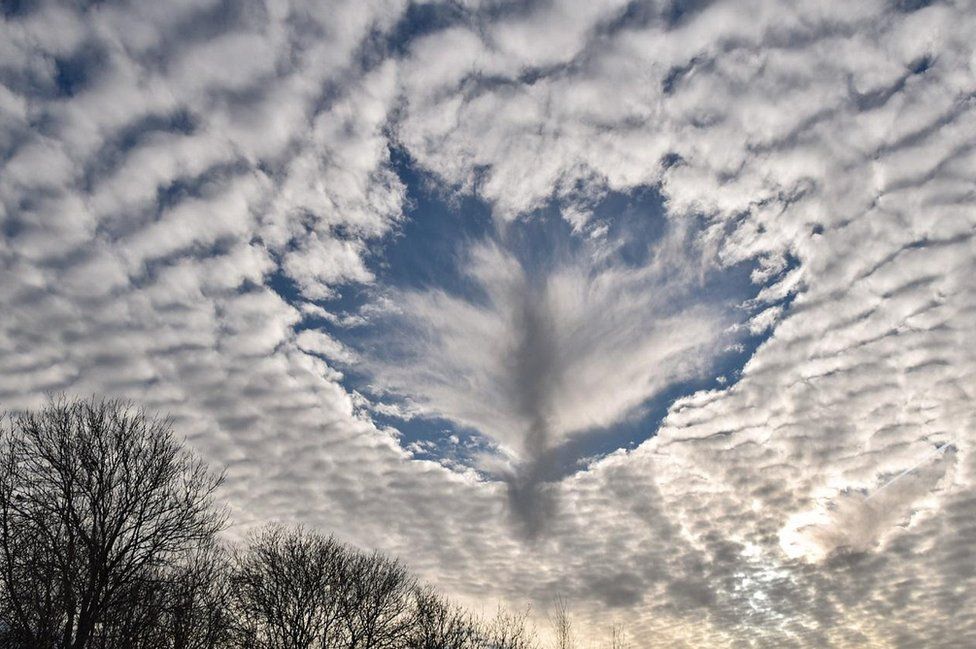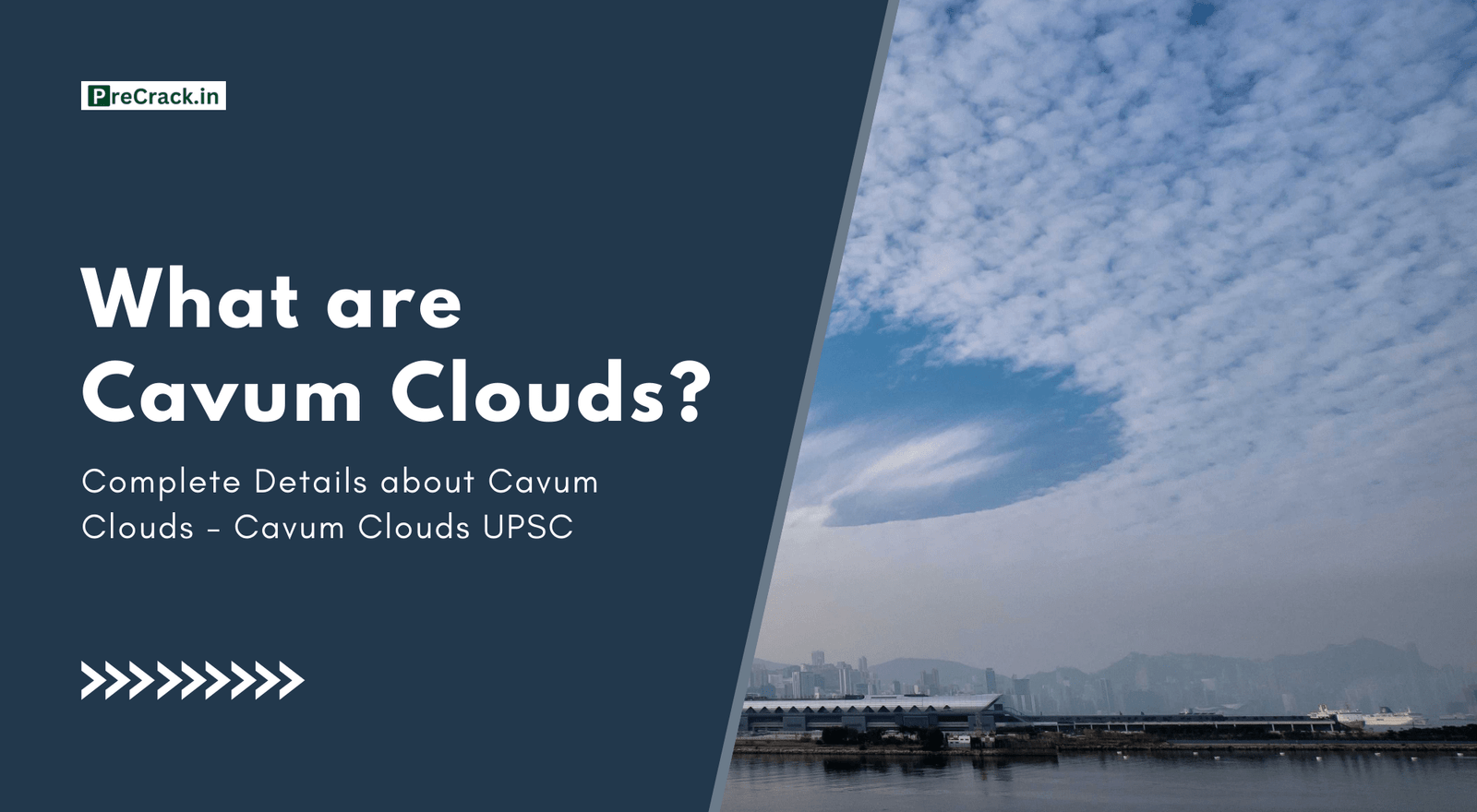Welcome to PreCrack! We’re here to provide you Information about all best topics in their simplest manner that may help you to Crack UPSC CS Prelims Exam.
Naresh Soni
What are Cavum Clouds? – All Details
Table of Contents
What are Cavum Clouds? – Cavum Clouds UPSC
Cavum clouds are also known as fallstreak holes or hole punch clouds. These are the large gaps that can appear in certain types of clouds. They usually look like big circles or ovals.

These gaps happen when water droplets in the clouds suddenly turn into ice or evaporate. Sometimes, passing airplanes can trigger this process. Cavum clouds are rare and unique, and because of their strange appearance, they’ve been mistaken for UFOs in the past.

Characteristics of Cavum Cloud
Cavum clouds, also known as fallstreak holes or hole punch clouds, have several distinct characteristics:

- Shape: They typically appear as large, circular or elliptical gaps in the clouds.
- Formation: Cavum clouds are formed when supercooled water droplets in the clouds suddenly freeze or evaporate. This often happens due to the introduction of ice crystals, which can be triggered by passing aircraft.
- Size: They can vary in size but are usually quite large, sometimes covering significant portions of the sky.
- Appearance: The edges of cavum clouds are usually well-defined, with a clear boundary separating the hole from the surrounding cloud cover.
- Rarity: Cavum clouds are relatively rare atmospheric phenomena, making them a unique sight when observed.
- Misidentification: Due to their unusual appearance, cavum clouds have occasionally been mistaken for unidentified flying objects (UFOs) by observers unfamiliar with their formation.
Types of Cavum Cloud
Cavum clouds, also known as hole punch clouds or fallstreak holes, typically occur in cirrocumulus or altocumulus clouds. However, they can be further categorized based on their appearance and altitude:
Altitude-based types
- Cirrocumulus cavum: These occur at high altitudes and are found in cirrocumulus clouds, which are thin, wispy clouds found at high levels in the atmosphere.
- Altocumulus cavum: These occur at mid-level altitudes and are found in altocumulus clouds, which are thicker and denser clouds compared to cirrocumulus clouds.
Shape-based types
- Circular cavum: These have a circular shape, appearing like large, round gaps in the cloud cover.
- Elliptical cavum: Some cavum clouds may have an elliptical shape, resembling ovals rather than perfect circles.
Appearance-based types
- Brush-like streaks: Some cavum clouds may have brush-like streaks of ice crystals below the hole. This appearance is caused by the rapid growth of ice crystals in the wake of passing aircraft.
- Smooth-edged holes: Others may have smooth, well-defined edges without distinct streaks.
Formation of Cavum Cloud
This is how Cavum Clouds form-
- Presence of supercooled water: The formation of cavum clouds begins in a cloud layer containing supercooled water droplets.
- Introduction of ice crystals: Ice crystals are introduced into the supercooled cloud layer, often triggered by passing aircraft creating disturbances in the air.
- Wegener-Bergeron-Findeisen process: The presence of ice crystals initiates the Wegener-Bergeron-Findeisen process, where water vapor preferentially deposits onto the ice crystals rather than the supercooled water droplets.
- Growth of ice crystals: As ice crystals grow, they cause surrounding supercooled water droplets to either evaporate or freeze onto the crystals.
- Formation of gap: The evaporation or freezing of the supercooled water droplets around the growing ice crystals creates a gap or hole in the cloud layer.
- Characteristics variation: The appearance and characteristics of the cavum cloud can vary depending on factors like temperature, humidity, altitude, and the size/density of ice crystals formed.
Features of Cavum Cloud
Here are the features of cavum clouds:
- Distinctive Appearance: Cavum clouds typically have a large, circular or elliptical gap in the cloud cover, creating a visually striking appearance.
- Well-Defined Edges: The edges of cavum clouds are usually sharp and clearly defined, separating the hole from the surrounding cloud cover.
- Rarity: Cavum clouds are relatively rare atmospheric phenomena, making them a unique sight when observed.
- Formation Mechanism: They form due to the sudden evaporation or freezing of supercooled water droplets in the cloud layer, often triggered by the introduction of ice crystals.
- Associated with Passing Aircraft: Cavum clouds can be induced by passing aircraft, which introduce disturbances that lead to the formation of ice crystals.
- Variable Size: While cavum clouds can vary in size, they often cover significant portions of the sky due to their large circular or elliptical shape.
- Misidentification: Due to their unusual appearance, cavum clouds have occasionally been mistaken for unidentified flying objects (UFOs) by observers unfamiliar with their formation.
- Different Types: Cavum clouds can occur in various types of cloud formations, including cirrocumulus and altocumulus clouds, and they may exhibit different characteristics based on altitude and shape.
Read Also | Role of AI in Cardiac Imaging – Complete Details – 10 UPSC Questions
Key Facts about Cavum Cloud
We have added some of the key facts about Cavum Clouds Below-
| Fact | Description |
| Cloud Name | Cavum Cloud (Hole-Punch Cloud, Fallstreak Hole) |
| Origin | Natural phenomenon, sometimes triggered by aircraft |
| Types | * Altocumulus (most common) * Cirrocumulus (less frequent) * Stratocumulus (least frequent) |
| Characteristics | * Dramatic hole (circular or linear) * Virga (icy trails) * Supercooled water droplets |
| Formation Process | 1. Supercooled water droplets present 2. Ice crystals introduced 3. Sublimation freezes droplets 4. Expanding hole as ice crystals fall 5. Virga forms from evaporating ice crystals |
| Recently Seen | Not specific due to fleeting nature, but can appear anywhere with suitable atmospheric conditions |
FAQs on Cavum Clouds
Question-1: What causes the formation of cavum clouds?
Answer. Cavum clouds form when supercooled water droplets in a cloud layer suddenly freeze or evaporate due to the introduction of ice crystals. This process can be triggered by passing aircraft or other disturbances in the atmosphere.
Question-2: Are cavum clouds rare?
Answer. Yes, cavum clouds are relatively rare atmospheric phenomena. While they can occur in various locations around the world, they are not commonly observed and are considered unique sights when they do appear.
Question-3: Can cavum clouds be mistaken for UFOs?
Answer. Yes, cavum clouds have occasionally been mistaken for unidentified flying objects (UFOs) due to their unusual appearance. The distinctive circular or elliptical gap in the cloud cover can resemble the shape of certain UFO sightings.
Question-4: In what types of clouds do cavum clouds typically form?
Answer. Cavum clouds typically form in cirrocumulus or altocumulus cloud formations. These clouds are characterized by thin, layered structures at high altitudes, where supercooled water droplets are present.
Question-5: Is there ongoing research on cavum clouds?
Answer. Yes, scientists continue to study cavum clouds to better understand their formation processes, characteristics, and potential impacts on weather patterns. High-resolution satellite imagery and observational studies are among the methods used to study cavum clouds in greater detail.



